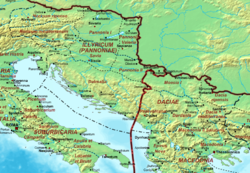Diocese of Dacia
| Diocese of Dacia Dioecesis Daciarum Διοίκησις Δακίας |
|||||
| Diocese of the Roman Empire | |||||
|
|||||
| Dacia and Illyria in 400 AD | |||||
| Capital | Serdica (modern Sofia) | ||||
| Historical era | Late Antiquity | ||||
| • | Split from Diocese of Moesia | ca. 337 | |||
| • | Merged into the newly formed Praetorian prefecture of Illyricum | 357 | |||
| • | Merged into the Praetorian prefecture of Italy | 384 | |||
| • | Merged back into Illyricum after Theodosius' death | 395 | |||
| • | Devastaded by the Avars | ca. 602 | |||
The Diocese of Dacia (Latin: Dioecesis Daciae) was a diocese of the later Roman Empire, in the area of modern western Bulgaria, central Serbia, Montenegro, northern Albania and northern Republic of Macedonia. It was subordinate to the Praetorian prefecture of Illyricum. Its capital was at Serdica (modern Sofia).
Emperor Aurelian (270-275), confronted with the secession of Gallia and Hispania from the empire since 260, with the advance of the Sassanids in Asia, and the devastations that the Carpians and the Goths had created in Moesia and Illyria, abandoned the province of Dacia created by Trajan and withdrew his troops altogether, fixing the Roman frontier at the Danube. A new Dacia Aureliana was organised south of the Danube out of central Moesia, with its capital at Serdica.
The abandonment of Dacia Traiana by the Romans is mentioned by Eutropius in his Breviarium historiae Romanae, book IX :
During the administrative reforms of Diocletian (284-305), the Diocese of Moesia was created, encompassing most of the central Balkans and the Greek peninsula. Later, however, probably in the time of Constantine the Great (306-337) the diocese was split in two, forming the Diocese of Macedonia in the south and the Diocese of Dacia, in the north.
...
Wikipedia

